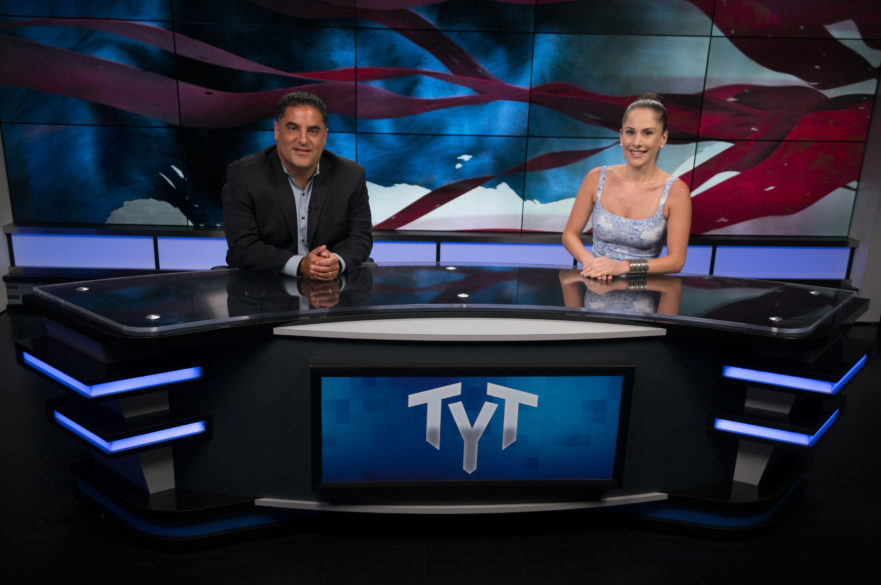By: James Warren
CLEVELAND — It was the modern-day, expletive-filled media version of the Jets and the Sharks squaring off in “West Side Story.”
“I want to have a rant-off with you,” shouted Alex Jones, a conservative radio talk host and conspiracy buff, as he arrived at the set of The Young Turks, a rising digital news operation covering the Republican National Convention that ended late Thursday.
He was trying to bait Cenk Uygur, its founder and an activist-journalist and former MSNBC host. To throw fuel on the fire, Jones not only gave Uygur a T-shirt with Bill Clinton’s image and the word “RAPE” emblazoned on it but also suggested the nearby Roger Stone, a notorious political operative and Donald Trump ally, crash the stage, too.
Ana Kasparian, the show’s co-host, told Jones “to shut the fuck up, bitch” as Uygur got up and told Jones to get the hell out in similarly vivid fashion, momentarily suggesting a bit of violence was imminent. Jones seemed to relish the whole scene.
It wasn’t quite “Meet the Press” or “Face the Nation.” But, in its own way, it was a window onto a fascinatingly fragmented digital news world with lots of digital-focused entrants like The Young Turks.
Started by the Turkish-American Uygur in 2002, The Young Turks began as a radio show on Sirius Satellite Radio and later on the failed left-leaning Air America. It since moved onto YouTube, Roku and Hulu and is now a multi-channel digital operation based in Los Angeles.
At both the Republican and next week’s Democratic conventions, it will have produced three shows a day: its flagship “The Young Turks,” “Reporters Roundtable” and “Conventional Wisdom.” The hosts include Uygur, Kasparian, Michael Shure and Ben Mankiewicz (who does double-duty as a host for Atlanta-based Turner Classic Movies).
In addition, it does its own interviews of politicians and speakers and was live on YouTube covering what proved to be the modest anti-Trump protests here. Oh, it also had a comedian, Jimmy Dore, roving around the convention floor and interviewing delegates.
“We’re doing serious shows that you could find on traditional radio or TV,” Uygur explained shortly before I was a guest on one of them, along with journalists Jonathan Alter and Melinda Henneberger, the editor of the Capitol Hill publication Roll Call. “We’ll be a bit more irreverent and have a bit more attitude. But we really have no rules.”
That mixture was evident in a second show I participated in that was hosted by Shure (a former Current TV and Al Jazeera America fixture) and also featured Errol Louis, a terrific politics host for NY1 and pundit for CNN. It was a bit looser than one would find on cable news but also far less hurried and not driven by any conservative vs. liberal programming paradigm.
In some instances, like “Reporters Roundtable,” somebody was live-streaming it for YouTube while somebody else recorded it and sent it to the studio in Los Angeles, where chyrons were put on and it was generally made to look more professional. That version then surfaced on YouTube, Facebook and other platforms it serves.
For “Conventional Wisdom,” The Young Turks used a more traditional setup, producing a small YouTube stage nestled inside the garage adjacent to Quickens Loan Arena that served as a primary media center throughout the week. It used several cameras for that shoot, put on chyrons immediately and edited any relevant video — like a more traditional show with an actual control room.
The Young Turks had 19 people here and will have 22 in Philadelphia. It did its first convention in 2004 when it was on Sirius radio “and we had to describe what was going on in media room to give listeners a mental image of it. Now we don’t have to do that. We can just pick up a mobile phone.”
“In traditional media, there are tight strictures about what you can do and the general tone of questioning,” Uygur continued. “You couldn’t make fun of the delegates. Here, of course, we can. And we want to learn about what motivates them. What made them so excited to spend own money, come here and support Trump? So it’s serious and irreverent.”
Of course, such a thrust is increasingly less the monopoly of non-mainstream media. The old mainstays, including the cable news networks, are clearly feeling pressure to be more iconoclastic as many exhibit a not-so-mild desperation to chase younger viewers, who tend to have decreasing interest in cable or broadcast news.
Imagine: MSNBC’s coverage included live versions of “Saturday Night Live” and “Weekend Update” segments from the convention. So one could find a rather abrupt segue from traditional punditry to comedy, then back to the punditry. It was Brian Williams, Rachel Maddow and Chris Matthews and, then, bingo, comics Colin Jost and Michael Che. Then, yes, it was back to Williams, Maddow and Matthews for the serious stuff.
Uygur figured that, for their shows, they had perhaps 5,000 or so watching live but ultimately perhaps an average of 200,000 when one factored in YouTube audiences.
Two days before the altercation with Jones, he told me that their general modus operandi might make some of their handiwork slightly resemble a reality show, especially as they gave the audience a sense of what was playing out in the media room itself.
“We just hope that, at the end of the day, the audience will be more informed, with a better sense of what happens here.”
Read it here: http://www.poynter.org/2016/how-the-young-turks-is-covering-the-2016-political-conventions/422866/

